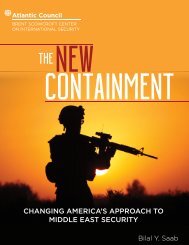POLITICS GOVERNANCE STATE-SOCIETY RELATIONS
Politics_Governance_and_State-Society_Relations_web_1121
Politics_Governance_and_State-Society_Relations_web_1121
Create successful ePaper yourself
Turn your PDF publications into a flip-book with our unique Google optimized e-Paper software.
<strong>POLITICS</strong>, <strong>GOVERNANCE</strong>, AND <strong>STATE</strong>-<strong>SOCIETY</strong> <strong>RELATIONS</strong><br />
I. THE COLLAPSE OF THE MIDDLE EASTERN<br />
<strong>STATE</strong> SYSTEM: WHY IT HAPPENED, HOW IT<br />
HAPPENED, AND WHAT IT MEANS<br />
The Middle East we see today represents the<br />
collapse of a regional order that prevailed for a<br />
half-century, as well as the collapse of several<br />
regional states into civil violence. The conflicts in<br />
today’s Middle East are not really about borders or<br />
territory, as much as they are about states and the<br />
type of governance they provide—what form they<br />
take, how they function, whom they privilege, and<br />
how they interact. 4 Some political forces seek to<br />
control existing state institutions, while others seek<br />
to supplant them and establish their own. 5<br />
At the same time, existing states in the region,<br />
feeling deep anxiety in the face of the post-2011<br />
disorder, struggle with one another for regional<br />
4 Some observers suggest that the breakdown in state-society<br />
relations, the emergence of failed states, and the increasing<br />
challenges to state authority region-wide are occurring because<br />
the states of the Middle East were artificial creations to begin<br />
with and never enjoyed the coherence of European nationstates.<br />
Renewing regional stability, such voices argue, demands<br />
a fundamental rethink of the nation-state system in the Middle<br />
East and a redrawing of so-called “Sykes-Picot” borders in the<br />
region to accommodate ethnic or sectarian differences that<br />
have been flashpoints for violence these past few years. See,<br />
for example, Tarek Osman, “Why border lines drawn with a ruler<br />
in WW1 still rock the Middle East,” BBC News, December 14,<br />
2013, http://www.bbc.com/news/world-middle-east-25299553;<br />
Bernhard Zand, “Century of Violence: What World War I Did<br />
to the Middle East,” Der Spiegel, January 31, 2014, http://www.<br />
spiegel.de/international/world/world-war-i-led-to-a-century-ofviolence-in-the-middle-east-a-946052.html;<br />
Michael Williams,<br />
“Sykes-Picot drew lines in the Middle East’s sand that blood is<br />
washing away,” Reuters, October 24, 2014, http://blogs.reuters.<br />
com/great-debate/2014/10/24/sykes-picot-drew-lines-in-themiddle-easts-sand-that-blood-is-washing-away/.<br />
But the notion that nation-states have “natural” borders<br />
defined by homogenous ethno-national communities is rooted<br />
more in nineteenth-century European romanticism than in<br />
historical or political reality, and this notion itself produced<br />
some of the bloodiest conflicts of the twentieth century. There<br />
is no reason to believe that changing state borders would be a<br />
magic bullet for resolving the inter-communal conflicts in Iraq<br />
or Syria. The fate of South Sudan, in which separation from the<br />
north simply unleashed a new conflict that had previously been<br />
subsumed in the north-south fight, is a good reminder that<br />
new fences do not necessarily make good neighbors. At the<br />
same time, the Kingdom of Jordan is multiethnic and multireligious,<br />
and its borders are classically “artificial” creations of<br />
Sykes-Picot—but it has nonetheless developed an impressive<br />
degree of social cohesion and so far successfully resisted the<br />
centripetal forces pulling the rest of the region apart.<br />
5 Yaroslav Trofimov, “Would New Borders Mean Less Conflict<br />
in the Middle East?” Wall Street Journal, April 10, 2015, http://<br />
www.wsj.com/articles/would-new-borders-mean-less-conflictin-the-middle-east-1428680793.<br />
power and influence. Saudi Arabia leads one pole<br />
of this power struggle, Iran the other, and the battle<br />
is fought in both failed and existing states across<br />
the region. This regional power struggle poses its<br />
own challenges to the goal of establishing effective,<br />
sustainable governance in the Middle East.<br />
The Roots of Regional Disorder: Why<br />
Arab Autocracy Failed<br />
Between roughly 1960 and 2011, the existing<br />
system of Arab states appeared to most observers<br />
as remarkably stable. Indeed, scholars of the region<br />
were largely occupied with explaining the durability<br />
of Arab authoritarianism in the face of the “third<br />
wave” of democratization that encompassed<br />
political transformation in regions as diverse as<br />
Central and Eastern Europe, Central and Southeast<br />
Asia, and Latin America. 6<br />
For nearly a half-century, Arab states relied on a<br />
model of governance that political science labels<br />
“corporatist.” They sought to make the state itself<br />
the central arena, overseer, and arbiter of most<br />
political, social, and economic activity. Interest<br />
groups like workers, religious institutions, and other<br />
societal groups were organized under the state’s<br />
umbrella and were expected to show loyalty in return<br />
for having their interests met by state action. 7 Civic<br />
action and organization outside the bounds set by<br />
the state were seen as threats to state authority,<br />
and were either co-opted and made subservient<br />
to the state, or suppressed. Arab governments<br />
maintained support by binding their populations to<br />
them through an effective mix of communal (ethnic,<br />
religious, or tribal) identity and political ideology;<br />
income from rents (that is, nontax income from<br />
natural resources or foreign assistance) that they<br />
distributed through state patronage; and effective<br />
security forces to both deter and suppress any<br />
prospect of domestic dissent.<br />
6 Lisa Anderson, “Arab Democracy: Dismal Prospects,”<br />
World Policy Journal, Vol. 18, No. 3 (Fall 2001) 53-60; Oliver<br />
Schlumberger, ed., Debating Arab Authoritarianism: Dynamics<br />
and Durability in Nondemocratic Regimes (Stanford, CA:<br />
Stanford University Press, 2007).<br />
7 Howard J. Wiarda, Corporatism and Comparative Politics: The<br />
Other Great Ism (Armonk, NY: M.E. Sharpe, 1997) 22-3.<br />
ATLANTIC COUNCIL<br />
11



